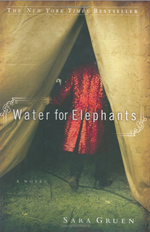Company: A Novel
by Max Barry
Amazon Description: “With broad strokes, Barry once again satirizes corporate America in his third caustic novel (after Jennifer Government). This time, he takes aim at the perennial corporate crime of turning people into cogs in a machine. Recent b-school grad Stephen Jones, a fresh-faced new hire at a Seattle-based holding company called Zephyr, jumps on the fast track to success when he’s immediately promoted from sales assistant to sales rep in Zephyr’s training sales department. “Don’t try to understand the company. Just go with it,” a colleague advises when Jones is flummoxed to learn his team sells training packages to other internal Zephyr departments. But unlike his co-workers, he won’t accept ignorance of his employer’s business, and his unusual display of initiative catapults him into the ranks of senior management, where he discovers the “customer-free” company’s true, sinister raison d’être.”
We read this for book club, and although it was a quick read and funny, we ultimately didn’t have a huge amount of discussion about it. I’m not sure if that’s because we all work for a big corporation and the subject is a bit too familiar, or if we really don’t think working for big companies as as bad as portrayed in this novel. Although the book was funny, I had to admit that it was pretty depressing. Logically, though, the company portrayed here couldn’t function in real life, and part of the conceit of the novel — removing the customers from the equation — is both the reason why it wouldn’t, and what keeps companies from spiraling out of control in this fashion.
Adventures from the Technology Underground: Catapults, Pulsejets, Rail Guns, Flamethrowers, Tesla Coils, Air Cannons, and the Garage Warriors Who Love Them
by William Gurstelle
Amazon Description: “What is the technology underground? According to engineer and technology consultant Gurstelle, it’s a community of like-minded amateurs–inventors, mostly, although some of them might more accurately be characterized as daredevils. Men and women who have devoted their lives to the things that conventional science has dismissed as unworkable, impractical, or just plain pointless. Flying cars, for example, or newfangled catapults, air guns, and flamethrowers. Or fighting robots and, of course, LDRS (large and dangerous rocket ships).”
This is Gurstelle’s second book – his other — Backyard Ballistics: Build Potato Cannons, Paper Match Rockets, Cincinnati Fire Kites, Tennis Ball Mortars, and More Dynamite Devices — is an older favorite of mine. Both are an entertaining read about technology and the people who, in the spirit of at least one of our founding fathers (Benjamin Franklin), enjoy experimenting with science for the sheer love of learning. These are folks who take science out of the realm of the academic and bring it to the masses, where it becomes a hands-on experience and a subject that everyone can learn and respect.
Hornswoggled (An Alafair Tucker Mystery)
by Donis Casey
Amazon Description: “Set in the prairie town of Boynton, Okla., in the spring of 1913, Casey’s nostalgic, folksy second novel to feature Alafair Tucker finds the full-time mother of 11 and part-time sleuth worried about one of her grown daughters, Alice. Alice is sweet on barber Walter Kelley, an attractive widower whom the determined and discerning Alafair mistrusts; Walter is just too popular with the ladies. Since Alice is set on having Walter, Alafair seeks distraction by investigating the unsolved murder of Louise Kelley, Walter’s late wife, whose stabbed body surfaced in a creek bordering the Tucker farm eight months earlier.”
This was really light reading, but fun, and it held together pretty well — no huge plot holes that make you put the book down in disgust. The author spent a lot of time on the pioneer homelife of the main character, which was a bit overkill for me, and the mystery sort of solves itself towards the end, but it was a nice relaxing book.
And then there’s the book that I picked up several times, but just couldn’t read at all:
My Dirty Little Book of Stolen Time
by Liz Jensen
I love the book title, I love the cover (I even took a picture of it when I spotted it in the bookstore in Chicago) and I loved the book’s premise, but I just couldn’t get further than a few chapters into it. For some reason, I just couldn’t identify with the main character. Here’s the description, if you want to give it a shot, though:
“When 25-year-old Charlotte Schleswig begins telling her madcap tale in 1897, she’s a successful prostitute roaming the suburban streets near Denmark’s capital. A random meeting in a bakery leads her to begin working as a domestic for Fru Krak, an anxious woman whose husband has recently disappeared under mysterious circumstances and who may now be haunting the very streets Charlotte walks. Charlotte soon sets out to find the missing Professor Krak, and in the course of her investigations discovers 21st-century London, a whole new world of mobile phones, microwaves, flavored condoms, suicide machines and a handsome archeologist named Fergus.”


